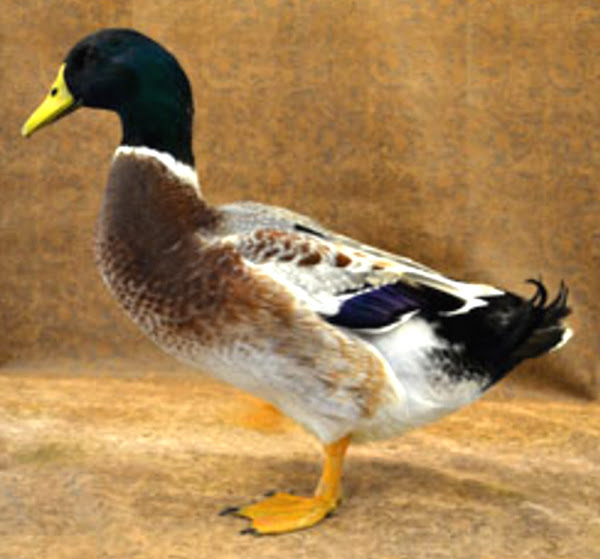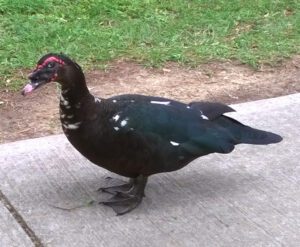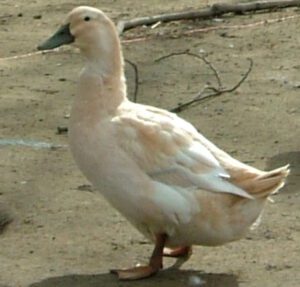The Welsh Harlequin duck is a light breed of domestic duck originating in Wales. It is a fairly new breed which was developed in the year of 1949 by Leslie Bonnet. He discovered a color mutation among his flock of Khaki Campbell ducks and began selectively breeding for the trait.
Welsh Harlequin duck is known for it’s high eggs production ability, and it is also noted for being calmer birds than the Khaki Campbells. They were a popular utility breed after their development. But as with so many duck breeds, their numbers dropped in the fifties and sixties.
The breed was first imported to the United States around 1968. Actually hatching eggs of the Welsh Harlequin duck were imported by John Fugate to Tennessee. But live birds were imported to the United States in 1981.
The breed was accepted into the American Poultry Association’s Standard of Perfection in the year of 2001. Now the number of Welsh Harlequin duck is not too much. And the breed is considered to be critically endangered in North America by the American Livestock Breeds Conservancy.
But the breed may be available in some other parts of the world. However review characteristics, uses, full breed profile and some special notes about the Welsh Harlequin duck below.
Welsh Harlequin Duck Characteristics
The Welsh Harlequin duck is classed as a light weight duck breed by the American Poultry Association. And the breed is well known for it’s good egg laying ability and also for it’s vivid plumage.
Welsh Harlequin ducks have relatively long bodies, rounded chest, moderately full abdomens, medium width backs and wide spaced legs. Their necks are topped with trim. They have oval heads that sport medium-long and slightly concave bills.
The females have a black bill with brown legs and feet. And their plumage is similar to a Mallard, but heavily frosted with white. They also lack the eye stripes of the Mallard females.
Welsh Harlequin drakes are also similar to a heavily frosted Mallard with a yellow/green bill and orange legs and feet. The patterning and color of the Welsh Harlequin duck is complex.

The drakes have greenish black head, reddish chestnut frosted with white shoulders, and their breast is creamy with reddish-chestnut. Their forewings are cream-white and reddish brown, with a shiny green and bronze cross-band. And their upper back has a tortoiseshell of cream, chestnut, brown and white.
The tail of the drakes is blackish/bronze edged with white. Their legs and feet are orange and the toenails are brownish-black. While the female Welsh Harlequins have a creamy white head with brown stippling.
Their crown of the head typically has more brown stippling than the rest of the head. Often there is a delicate light rust or burnt orange blush to her head, neck, and breast.
Usually the body of the female Welsh Harlequins is creamy white with buff and brown-green or bronze when young, and typically brown when older. And their toenails are brownish-black.
There is also a color variation of the Welsh Harlequin duck known as ‘Golden’, which is popular in the United Kingdom. This color variation replaces the black feather pigments with a light golden brown color. Average body weight of the Welsh Harlequin duck is between 2 and 2.5 kg. Photo from The Livestock Conservancy.
Uses
The Welsh Harlequin duck is a very good egg laying duck breed. It is suitable for commercial duck farming business for egg production. But as a light weight duck breed, these birds produce a lean carcass and it is also suitable for meat production.
Special Notes
Welsh Harlequin duck is one of the fantastic egg laying duck breeds. They can lay up to 250 eggs per year. They are also noted for being calmer birds than their ancestor, the Khaki Campbells.
Welsh Harlequin ducks are friendly, docile and placid birds. They usually don’t fly and are very happy to stay in backyard or garden. They are also very good foragers and usually forage enthusiastically in the garden or backyard for insects.
The Welsh Harlequin drakes have a high libido. So it is wise not to keep more than one drake in a small pen, otherwise the females will be damaged. The Welsh Harlequin duck breed is prone to broodiness. And usually a pair can produce ducklings easily without human interference.
The gender of the ducklings can be determined easily after hatching by their bill color (with about 90 percent accuracy). The ducklings with darker bills are male, and lighter bills ending in a dark spot are usually females.
Although this distinction disappears within several days. However it is a beautiful utility bird. Review it’s full breed profile below.
| Breed Name | Welsh Harlequin |
| Other Name | None |
| Breed Purpose | Egg layer |
| Special Notes | Calmer, Friendly, Docile |
| Breed Class | Light |
| Broodiness | Average |
| Weight | 2 to 2.5 kg |
| Climate Tolerance | All Climates |
| Egg Color | White |
| Egg Size | Large |
| Egg Weight | 75-85 grams |
| Egg Productivity | High |
| Flying Ability | Poor |
| Rarity | Common |
| Varieties | Silver & Golden |
| Country of Origin | Wales |






